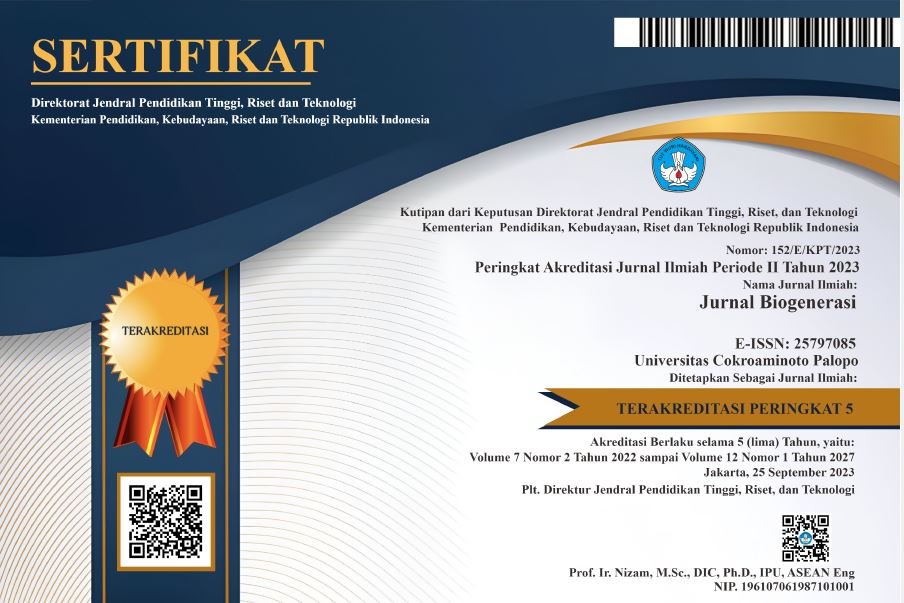KEANEKARAGAMAN JENIS BIVALVIA DI DESA PARITI KABUPATEN KUPANG
DOI:
https://doi.org/10.30605/biogenerasi.v10i2.5545Keywords:
diversity, bivalves, kupang regency, ecologyAbstract
Bivalves have a very important ecological role in coastal waters. As benthic organisms, bivalves function in the filtration process, filtering small particles such as phytoplankton from seawater. This process is not only important for the survival of the bivalves themselves, but also affects water quality and the sustainability of the ecosystem as a whole. The method used in this research is a survey method that includes field data collection, this research was conducted in Pariti Village, Kupang Regency. Data collection was carried out to identify the types of bivalves found in the coastal area of Pariti Village. The methods used were linear transects and quadrat sampling. The analysis that will be carried out includes the shannon-wiener diversity index, evenness index, simpson dominance index and margalef species richness index. Based on the results of field surveys conducted in Pariti Village, Kupang Regency, at three different stations, seven bivalve species were found, namely Anadara granosa, Anadara antiquata, Perna viridis, Crassostrea gigas, Meretrix meretri, Tellina timorensis and Pitar tumens. The ecological index shows that the coastal ecosystem of Pariti Village has a moderate level of diversity (H'=1.564) with a relatively even distribution of species (E=0.873). Species richness was also quite good with species richness index values indicating that there were many bivalve species present (R1=0.739), although there were few dominant species. The low dominance index (C=0.192) indicates that the ecosystem is not dominated by a single species, indicating stable ecosystem conditions.
Downloads
References
Cunningham, C. J., Denny, M. A., & Martinez, M. P. (2001). Bivalve ecology and their role in marine ecosystems. Oceanography and Marine Biology: An Annual Review. 39, 335-380.
Gosling, E. M. (2003). Bivalve molluscs: Biology, ecology and culture. Blackwell Science.
Hadi, M., Sutrisno, A., & Prasetyo, L. B. (2015). The biodiversity of bivalves in the coastal waters of Kupang. Jurnal Ilmu Kelautan. 22(3), 187-193.
Fahik, M. 2023. Keanekaragaman Jenis Serangga Di Sekitar Tanaman Padi Areal Persawahan Motaulun Malaka Barat. Jurnal Biogenerasi. 8(2), 623-627.
Fahik, M. 2024. Keanekaragaman Jenis Pohon Di Sekitar Universitas San Pedro, Kota Kupang Nusa Tenggara Timur. Jurnal Biogenerasi. 10(1), 169-174.
Prasetyo, L. B., Aji, M., & Hadi, M. (2019). Ecological factors influencing the diversity of bivalves in Indonesia’s coastal ecosystems. Journal of Coastal Research. 35(6), 1169-1178.
Downloads
Published
How to Cite
Issue
Section
License
In submitting the manuscript to the journal, the authors certify that:
- They are authorized by their co-authors to enter into these arrangements.
- The work described has not been formally published before, except in the form of an abstract or as part of a published lecture, review, thesis, or overlay journal.
- That it is not under consideration for publication elsewhere,
- That its publication has been approved by all the author(s) and by the responsible authorities – tacitly or explicitly – of the institutes where the work has been carried out.
- They secure the right to reproduce any material that has already been published or copyrighted elsewhere.
- They agree to the following license and copyright agreement.
License and Copyright Agreement
Authors who publish with this journal agree to the following terms:
- Authors retain copyright and grant the journal right of first publication with the work simultaneously licensed under Creative Commons Attribution License (CC BY 4.0) that allows others to share the work with an acknowledgment of the work's authorship and initial publication in this journal.
- Authors are able to enter into separate, additional contractual arrangements for the non-exclusive distribution of the journal's published version of the work (e.g., post it to an institutional repository or publish it in a book), with an acknowledgment of its initial publication in this journal.
- Authors are permitted and encouraged to post their work online (e.g., in institutional repositories or on their website) prior to and during the submission process, as it can lead to productive exchanges, as well as earlier and greater citation of published work.


.png)

